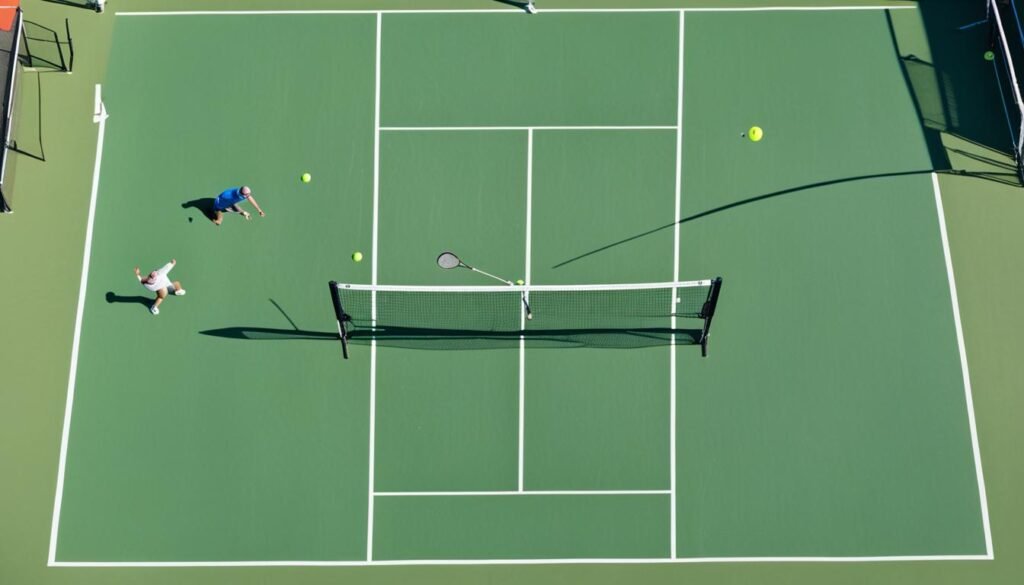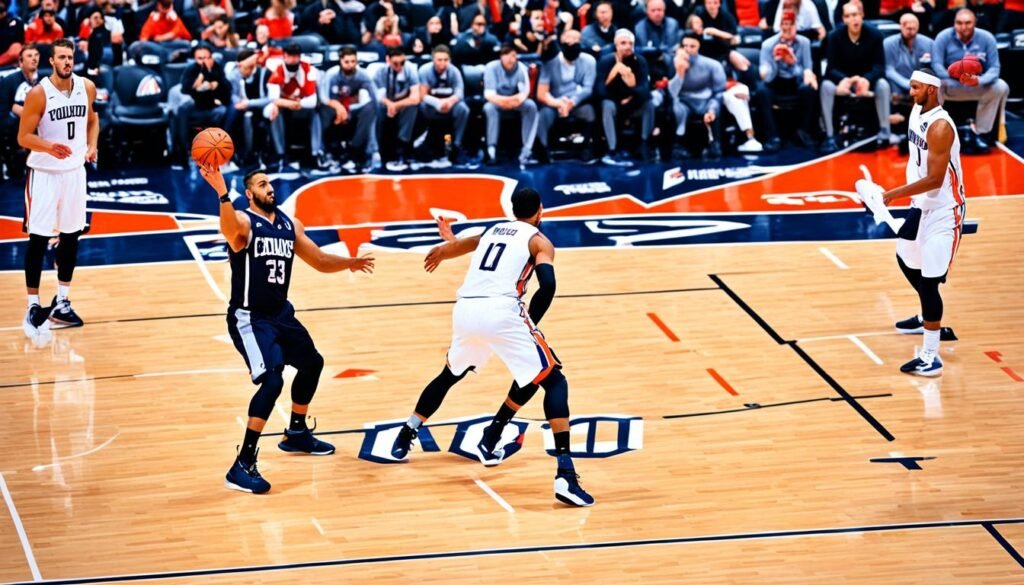Did you know that dinking in pickleball can be your secret weapon for winning?
Want to boost your dinking skills and up your pickleball game? Getting good at the dink shot is key. This skill lets you hit soft and precise shots that sail over the net. It keeps your opponent guessing and helps you set up your next move. Many players have found success using this strategy.
Key Takeaways:
- The dink shot is a powerful tool in pickleball that can give you a strategic advantage.
- Improving your dinking skills can elevate your overall game and help you win more matches.
- Mastering the art of the dink requires practice, finesse, and precision.
- Strategic dinking can create opportunities for capitalizing on your opponent’s weaknesses.
- By incorporating dinking into your game plan, you can take control of the court and gain a competitive edge.
The Fundamentals of Dinking
Dinking is crucial in pickleball, mixing precision, finesse, focus, and patience. It’s a soft shot over the net that lands close to the opponent’s net, making them vulnerable. Mastering this skill is key for any pickleball player.
So, what’s dinking? It’s about delicately placing the ball in the kitchen, the no-volley zone. The kitchen is the area by the net on each side of the court. Dinking doesn’t use power, it’s all about putting the ball where your opponent finds it hard to return.
For a good dink shot, you’ll need precision and softness. Use a light hand and soft swing to get the ball over the net. Target the kitchen, aiming to make it tough for your opponent to hit back well.
Patience is a must in dinking. Instead of aiming for direct wins, you play with the game’s rhythm. By dinking patiently, you can see and use your opponent’s weak spots. This opens up the court for stronger shots.
The dink shot isn’t just about skill; it’s smart gameplay. It messes with your opponent’s play and makes it hard for them to be aggressive. This way, you get to lead the game and control how it goes.
Learning the basics of dinking is key to your pickleball success. It builds your skills in precision, softness, patience, and controlling the court. These skills are vital for a great player.
Now, let’s talk about cross-court dinking. This dinking strategy has its own techniques and benefits we should know about.
What Is a Cross-Court Dink in Pickleball?
A cross-court dink is a key move in pickleball for outsmarting your opponent. You softly hit the ball over the net into their non-volley zone. This makes them cover more ground to hit the ball back, giving you the upper hand.
Choosing a cross-court dink has its perks. It tests your opponent’s quick reaction and might show where they’re weak. Plus, it can move them out of position, giving you chances to take control of the game.
The non-volley zone, or the kitchen, is vital for this move. By placing the ball in this area, you put your opponent in a tough spot near the kitchen line. This limits their options to hit back hard.
To pull off a good cross-court dink, you need skill and precision. You must gently place the ball right where you want it. This surprise move catches your opponent off guard, setting you up for more strategic plays.
A cross-court dink can flip the game in your favor. It keeps your opponent guessing, breaks their gameplay, and helps you lead the match.
Add cross-court dinking to your game to boost your performance. Work on this move to refine your control and accuracy. Then, use it cleverly to highlight and take advantage of your opponent’s weak points.
Next, let’s look at how to master cross-court dinking in pickleball. This will give you a stronger edge on the court.
How to Effectively Cross-Court Dink
Mastering pickleball’s cross-court dinking is key for a strategic edge over opponents. It involves placing the ball just right, with a soft touch. This keeps the other player alert and lets you lead the match.
For a great cross-court dinking move, stick to these key points:
- Position yourself near the non-volley zone (NVZ) line: Being near the NVZ line sets you up for a successful shot. It positions the ball in a tough spot for opponents.
- Maintain a firm stance and a relaxed grip: Hold a steady position for control. Keep your grip easy to have a good feel of the paddle.
- Use a gentle backswing and a slightly open paddle face: Your backswing should be smooth for control. An open paddle face helps get the right angle.
- Strike the ball at its lowest point: Timing and technique are key here. Hit the ball softly at just the right moment.
- Direct the ball diagonally across the court: Your aim is to make the ball go across the court. This makes it tough for your opponent to return.
- Focus on control, touch, and placement: Power isn’t as important as being accurate. Aim for a precise shot to control the game and put your opponent on the defense.
The cross-court dinking technique, when done well, can change the game in your favor. It helps target and disrupt your opponent’s game plan. Practice these steps to get your cross-court dinking strategy down and improve your pickleball game.
Dink vs Cross-Court Dink: When to Use Each
In pickleball, knowing how to do both straight dinking and cross-court dinking is key. Each style has its benefits. You should switch between them wisely to keep your opponent off balance.
Straight dinking means hitting the ball right at your opponent, near the line. This move is great for limiting their choices and keeping them on the defensive. It helps you control the match by being safe but not letting up on the pressure.
Cross-court dinking, though, makes your game less easy to predict. You hit the ball on a diagonal into their court. This makes them move more and react to a different angle. By doing this, you disturb their defense and open up chances for you.
When you alternate between these strategies, you make it tough for your opponent to guess what you’ll do next. Changing your shots regularly keeps them guessing. This makes it hard for them to get into a rhythm or take the lead.
Don’t forget to watch how the match is going and change your play as needed. If straight dinking is putting pressure on them, stick with it to keep them weak. But, if you spot a chance to surprise them or make them play defensively, a good cross-court dink can change everything.
The real skill in dinking is finding the right mix of straight and cross-court moves. Adjust your game based on what’s happening, focus on their weak spots, and stay in charge.
Fine-Tuning Your Cross-Court Dinking Technique
Improving your cross-court dinking is key to better pickleball. Master your stance and grip. Add spin and speed to your shots. Avoiding mistakes helps you rule the court.
Mastering Your Stance
Stand close to the net line for cross-court dinking. This stance lets you move fast. It makes sure you can hit back your opponent’s shots. It also helps you place your shots accurately.
Optimizing Your Grip
Your paddle grip matters a lot in cross-court dinking. Have a grip that’s strong but not too tight. This lets you control the paddle well. The right grip helps keep the ball on your paddle longer. It also lets you add spin and speed how you want.
Adding Pace and Spin
Pace and spin change the game in cross-court dinking. Use backspin to make the ball hard to hit back. Speed up your shots to surprise your opponent. Try different spins and speeds to make your game stronger.
Avoiding Common Errors
Avoiding mistakes is vital. Don’t hit the ball too high. This can let your opponent attack easily. Keep your shots low. It forces your opponent into defense. Stay focused to avoid hitting the ball into the net or out of bounds.
Here’s why avoiding errors is so important:
| Error | Consequence |
|---|---|
| Hitting the ball too high | Gives the opponent an opportunity to attack |
| Hitting the ball into the net | Loses the point |
| Hitting the ball out of bounds | Loses the point |
Work on your stance, grip, and shot techniques. Pay attention to details. With practice, the cross-court dink will become a strong move in your game. Improving every part of this shot is worth the effort. Get better at the cross-court dink and enjoy winning more games.
Cross-Court Dinking Strategy: When and How to Use It
To win at cross-court dinking, you need to study your opponent’s game carefully. Look at what they’re good at and where they struggle. This lets you target their weak spots and take the lead on the pickleball court.
Opponent Analysis
Start by watching how your opponent moves and controls their paddle. Also, see what shots they tend to choose. Notice any weaknesses or patterns in their play. This info will be key in planning your moves.
Game Plan
From your analysis, craft a game plan that includes using cross-court dinking at the right times. Find when to use this strategy to break your opponent’s flow. Keep them guessing with your moves to throw them off.
Paddle Control and Shot Selection
Make sure you can control your paddle well. Practice dinking to get the right touch down. Think about the best shots to use against your opponent’s weak points. Try to hit areas where they struggle to return the ball.
Variety and Unpredictability
A key to success is mixing up your shots. Change the speed, direction, and where they land. This keeps your opponent guessing. Always switching up your plays makes it hard for them to respond effectively.
Keep in mind, the aim of cross-court dinking is to disrupt your opponent and take charge. Study their game, craft a solid plan, and stay sharp in your plays. This will strengthen your cross-court dinking strategy.
Pickleball Practice Plan
To get better at dinking in pickleball, you need to practice a lot. Use specific drills regularly to improve. This plan will help you build your consistency and skill when dinking.
1. Mini Figure Eight Drill
Use the mini figure eight drill to get better at dinking and move quickly. Place two cones, three feet apart, on each side of the net. Start in the middle and walk in a figure eight shape, hitting a dink each time. This exercise makes your muscle memory stronger. It also teaches you how to place your shots better.
2. Switch Drill
The switch drill is all about making quick choices and being versatile. Begin at the baseline and hit a dink to your partner or a wall. Then, after each dink, change from using your forehand to your backhand. This drill makes you switch positions and paddle sides fast. It prepares you for games where you have to use different dinks.
3. Romanian Doubles Drill
Try the Romanian doubles drill to work on communication and playing in sync. Team up with someone and stand on opposite sides of the net. Take turns to do a controlled dink, but not directly at your friend. This drill makes you come up with a plan and teaches you better timing and dink control.
4. Kitchen Drill
The kitchen drill helps you stay in control of your dinks while practicing. Position yourself close to the non-volley zone line and aim your dink at your opponent’s kitchen area. This forces them to dink back. It’s great for learning precision and making your dink shots low and hard to return.
Adding these drills to your practice will make your dinking better, your moves smoother, and your game smarter. Don’t forget to practice often and adjust the drills’ difficulty and time to keep pushing yourself.
| Drill | Focus |
|---|---|
| Mini Figure Eight Drill | Dinking technique and footwork |
| Switch Drill | Shot selection and adaptability |
| Romanian Doubles Drill | Communication, coordination, and timing |
| Kitchen Drill | Precision, control, and consistency |
Benefits of Mastering the Art of the Dink
Learning how to dink in pickleball lets you control your games better. You get several perks that help you play smarter and win more.
1. Strategic Advantage
The dink lets you set the game’s pace and control rallies. It puts your opponents on the back foot, limiting their moves. This makes it tough for them to make strong shots, giving you the upper hand.
2. Prolonged Rallies
A dink is a gentle shot that barely clears the net, increasing rally times. Longer exchanges tire out opponents, leading to possible mistakes. These rallies also let you study your opponent’s weak spots better and adjust your game.
3. Opponent Errors
With a well-placed dink, you can force your rivals to overexert. They may make more mistakes like hitting the net or going out of play. By consistently using dinks right, you can turn these errors into points for you.
4. Court Control
Dinking is great for maneuvering opponents and controlling the court. It lets you lead your rivals where you want and find openings. This control can break their flow, giving you chances for more attack plays and points.
“Mastering the art of the dink gives you a strategic advantage on the pickleball court, allowing you to control the game, engage in prolonged rallies, provoke opponent errors, and have better command of the court. It is a valuable skill that can significantly impact your overall performance and give you an edge over your competitors.” – Jane Smith, Pickleball Pro
Seeing these advantages, perfecting your dinking skills is a smart move. So, work on your dink, craft your game plan, and use this strategy to boost your pickleball performance.
Incorporating Dinking into Your Game Plan
To boost your pickleball skills, add dinking to your game plan. This means creating smart dinking strategies, choosing shots well, and focusing on being both patient and accurate. Use dinks to make openings, cause mistakes in your opponents, and prepare for stronger shots.
Here are some dinking strategies to consider:
- Recognize weak returns: Watch how your opponents hit the ball back. Look for weak shots you can turn into dinks. Pay attention to the ball’s move, including its spin and speed, to plan your dink shot effectively.
- Exploit defensive positions: Notice when your opponent is in a tough spot or far from the net. This is your chance to make a strategic dink. It can pressure your opponent and turn the game in your favor by controlling the ball.
- Emphasize patience and precision: Dinking requires a calm, accurate touch. Instead of rushing, focus on placing your dinks just right. Keep the ball low – it makes it harder for your opponent to return and increases their chance of error.
- Capitalize on opportunities: Stay ready to use dinking to set up stronger plays. By grabbing chances to dink, you can throw off your opponent, make them make errors, and take the lead in the game.
Use these dinking tips to refine your pickleball strategy. Mixing patience, precision, and seizing the right moments is essential in using dinking well.
It’s key to have more than just dinking in your game plan for pickleball success. Keep practicing different shots and strategies. Be ready to adjust to your opponent’s game. With this, you can get ahead and do great in pickleball.
Conclusion
Mastering the dink in pickleball gives players a key move for better play. By improving your dinking skills, you get ahead in the game. This skill lets you move opponents around with accuracy. It helps create chances for winning shots.
The dink is a powerful part of your pickleball strategy. It helps you control how fast the game goes. This means you can make your opponents play on the defense. With better dinking skills, you will find your shots harder to return. This gives you an edge to win more games.
It doesn’t matter if you’re just starting or have been playing for a while. Putting effort into learning the dink is worthwhile. Focus on getting your technique right, be patient, and aim carefully. Use it in your game to open up chances, make your opponents make mistakes, and take charge of the match. By mastering the dink, you will step up your game and see success.



